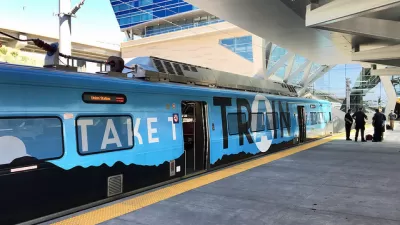Rail has transformed the Mile-High City, and the new University of Colorado A Line from Union Station to the airport is but one of many lines that has turned Denver one of the nation's fastest growing and attractive cities. And more lines are coming!
POLITICO gave its article a rather odd name: "The train that saved Denver." Clearly the nation's newest commuter rail deserves all the praise it gets, but Denver didn't need any saving, as Colin Woodard, contributing editor at Politico Magazine, writes in this comprehensive piece. It was thriving well before the A Line opened on Earth Day.
If anything needs saving, it may be rail itself, and public-private partnerships, instrumental to the completion of the line, could use the praise.
At a moment when aging mass transit systems in several major cities are capturing headlines for mismanagement, chronic delays and even deaths, Denver is unveiling a shiny new and widely praised network: 68 stations along 10 different spurs, covering 98 miles, with another 15 miles still to come.
Credit: RTD FasTracks Map
Referring to the city's new commuter rail network, including the Gold Line (opening this year) and Northwest Rail Line (opening July 25), both originating from Union Station, Woodard praises "an unprecedented public-private partnership that combines private funding, local tax dollars and federal grants," adding that "Denver has done something no other major metro area has accomplished in the past decade, though a number of cities have tried."
Woodard goes on describe how Denver's light rail system, eighth highest in ridership in the United States, has transformed the Mile-High City.
Originally intended to unclog congested highways and defeat a stubborn brown smog that was as unhealthy as it was ugly, the new rail system has proven that its greatest value is the remarkable changes in land use its stations have prompted, from revitalizing moribund neighborhoods, like the area around Union Station, to creating new communities where once there was only sprawl or buffalo grass.
“We are talking about a culture-transforming moment,” says Denver mayor Michael Hancock. “Light rail has really moved Denver into the 21st century.”
"The $7.6 billion FasTracks project has created a transit system that is already altering Denver’s perception of itself, turning an auto-centric city into a higher-density, tightly-integrated urban center that aims to outcompete the bigger, older coastal cities on the global stage," writes Woodard.
In recent years, Denver has been storming national rankings lists: Brookings Institution demographer William Frey’s best (2011) and second best [PDF] (2013) city for attracting millennials; the best city for college graduates (2014, Apartments.com); the largest increase in residents with college degrees (U.S. Census, 2014); the best commercial real estate market (Coldwell Banker, 2015); the second best for launching a startup (2014, Forbes); and, this year, U.S. News and World Report’s best place to live.
The same day the article was published, the Census Bureau released new numbers showing that Denver jumped two places to land in the top 20 most populous cities, "moving up two spots to 19th."
It displaced Detroit, which fell from 18th to 21st. In addition, Seattle moved up two spots to 18th. Denver and Seattle were both among the nation’s 11 top numerically gaining cities.
Among cities with populations of 50,000 or more showing numeric population increases between between July 1, 2014, and July 1, 2015, Denver scored #9, adding 18,582 people for a total of 682,545.
One sour note on transportation missed by Woodard, understandably because it's not on public transit. As of last year, the Denver Moves bike plan was underfunded, as noted by Planetizen contributing editor Philip Rojc.
Hat tip to Martine Powers, POLITICO Morning Transportation.
FULL STORY: The Train That Saved Denver

Trump Administration Could Effectively End Housing Voucher Program
Federal officials are eyeing major cuts to the Section 8 program that helps millions of low-income households pay rent.

Planetizen Federal Action Tracker
A weekly monitor of how Trump’s orders and actions are impacting planners and planning in America.

Ken Jennings Launches Transit Web Series
The Jeopardy champ wants you to ride public transit.

Driving Equity and Clean Air: California Invests in Greener School Transportation
California has awarded $500 million to fund 1,000 zero-emission school buses and chargers for educational agencies as part of its effort to reduce pollution, improve student health, and accelerate the transition to clean transportation.

Congress Moves to End Reconnecting Communities and Related Grants
The House Transportation and Infrastructure Committee moved to rescind funding for the Neighborhood Equity and Access program, which funds highway removals, freeway caps, transit projects, pedestrian infrastructure, and more.

From Throughway to Public Space: Taking Back the American Street
How the Covid-19 pandemic taught us new ways to reclaim city streets from cars.
Urban Design for Planners 1: Software Tools
This six-course series explores essential urban design concepts using open source software and equips planners with the tools they need to participate fully in the urban design process.
Planning for Universal Design
Learn the tools for implementing Universal Design in planning regulations.
Heyer Gruel & Associates PA
Ada County Highway District
Institute for Housing and Urban Development Studies (IHS)
City of Grandview
Harvard GSD Executive Education
Toledo-Lucas County Plan Commissions
Salt Lake City
NYU Wagner Graduate School of Public Service





























